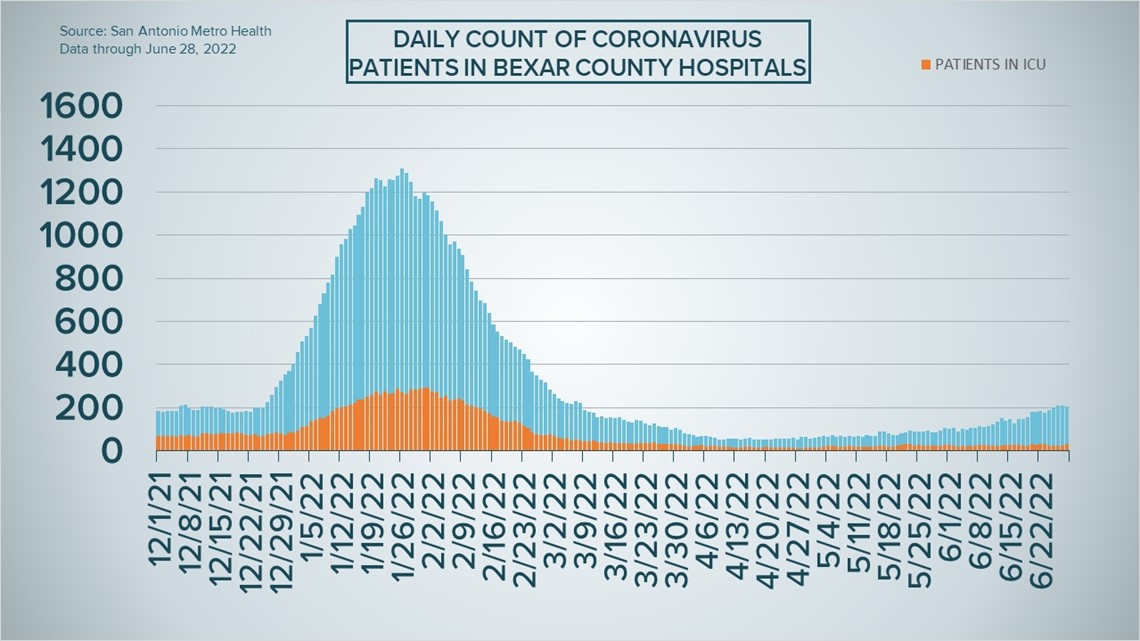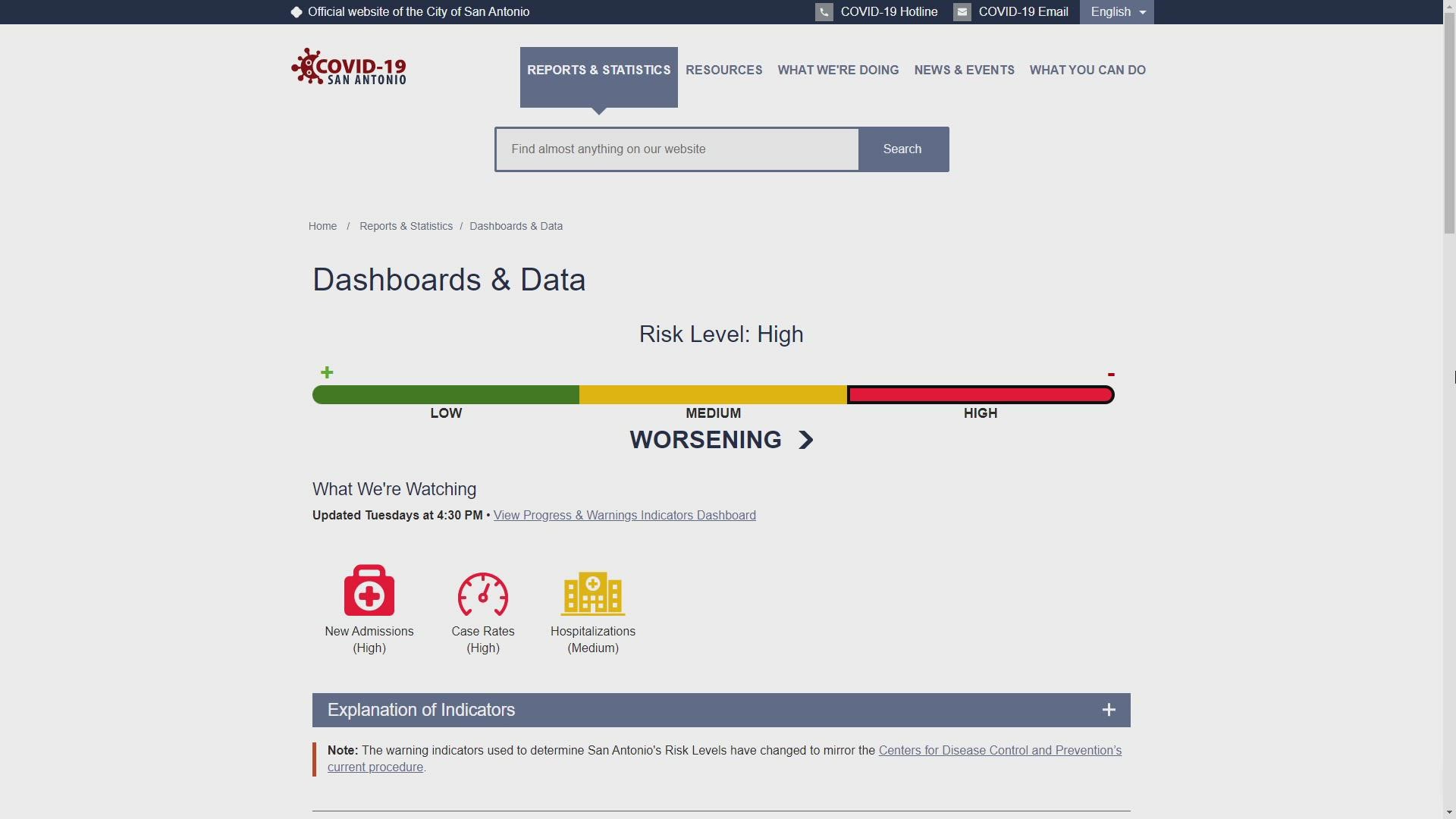SAN ANTONIO — The risk level for coronavirus spread in the San Antonio was upped to its highest threshold Tuesday amid a steady rise in virus-related hospitalizations.
Sunday saw the number of local patients receiving treatment climb to over 200 for the first time since early March. On Tuesday there were 204 local COVID-19 hospitalizations, which is the metric Metro Health has begun to prioritize in the later stages of the pandemic.
The hospitalizations figure has increased 50% since June 1.
Another 863 COVID-19 infections were reported Tuesday as the county also contends with an uptick in cases that began in late April. While the seven-day new case average has slowly risen over the last several weeks, San Antonio has managed to avoid a surge similar to January's omicron wave.
June has averaged 648 new cases a day, nearly two and a half times the 274 daily infections yielded in May.
San Antonio Mayor Ron Nirenberg took to Twitter to remind the community to stay vigilant, and health officials said it remans important that residents be tested if they're feeling symptoms, especially as Fourth of July approaches.
Of the 204 Bexar County residents hospitalized Tuesday, 32 are in intensive care and four are using ventilators. One more resident has died of virus complications, bringing the death toll to 5,339, while at least 569,000 infections have been reported in Bexar County.
How Bexar County is trending




Vaccine Progress in Bexar County
The following numbers are provided by San Antonio Metro Health. A full breakdown can be found here.
- 1.457 million eligible Bexar County residents are fully vaccinated as of Monday, June 20.
- More than 552,000 eligible Bexar County residents have received a COVID-19 booster shot, including 77,263 residents who are fully boosted, as of Monday, June 20.
The CDC states that "when a high percentage of the community is immune to a disease (through vaccination and/or prior illness)," that community will have reached herd immunity, "making the spread of this disease from person to person unlikely."
The City of San Antonio breaks down the vaccination rates by zip code on Metro Health's Vaccination Statistics page.
Coronavirus in Texas
The total number of coronavirus cases in the state since the pandemic began grew by 9,770 on Tuesday, according to the Texas Department of State Health Services. That total includes 6,740 new confirmed cases and 3,030 new probable cases. More details can be found on this page.
Tuesday's figures bring the total number of Texans diagnosed with COVID-19 to more than 7 million.
An additional eight Texans have died from virus complications, meanwhile, raising the statewide death toll to 87,072.
Coronavirus symptoms
The symptoms of coronavirus can be similar to the flu or a bad cold. Symptoms include fever or chills, cough, shortness of breath or difficulty breathing, fatigue, muscle or body aches, headache, new loss of taste or smell sore throat, congestion or runny nose, nausea or vomiting, and diarrhea, according to the Centers for Disease Control.
Most healthy people will have mild symptoms. A study of more than 72,000 patients by the Centers for Disease Control in China showed 80 percent of the cases there were mild.
But infections can cause pneumonia, severe acute respiratory syndrome, kidney failure, and even death, according to the World Health Organization. Older people with underlying health conditions are most at risk.
Experts determined there was consistent evidence these conditions increase a person's risk, regardless of age:
- Chronic kidney disease
- COPD (chronic obstructive pulmonary disease)
- Obesity (BMI of 30 or higher)
- Immunocompromised state (weakened immune system) from solid organ transplant
- Serious heart conditions, such as heart failure, coronary artery disease, or cardiomyopathies
- Sickle cell disease
- Type 2 diabetes
- The CDC believes symptoms may appear anywhere from two to 14 days after being exposed.
Human coronaviruses are usually spread...
- Between people who are in close contact with one another (within about 6 feet).
- Through respiratory droplets produced when an infected person coughs, sneezes or talks. These droplets can land in the mouths or noses of people who are nearby or possibly be inhaled into the lungs.
- Some recent studies have suggested that COVID-19 may be spread by people who are not showing symptoms.
Help stop the spread of coronavirus
- Stay home when you are sick.
- Eat and sleep separately from your family members
- Use different utensils and dishes
- Cover your cough or sneeze with your arm, not your hand.
- If you use a tissue, throw it in the trash.
Find a Testing Location
City officials recommend getting a COVID-19 test if you experience fever or chills, cough, shortness of breath or difficulty breathing, fatigue, muscle or body aches, headache, new loss of taste or smell, sore throat, congestion or runny nose, nausea or vomiting, or diarrhea.
Here's a Testing Sites Locator to help you find the testing location closest to you in San Antonio.
Latest Coronavirus Headlines
- FDA advisers to debate modifying COVID vaccine for fall
- Pfizer says tweaked COVID-19 shots boost omicron protection
- COVID-19 vaccines saved nearly 20 million lives worldwide, scientists say
- FEMA reimbursing San Antonio millions for providing COVID-related shelters and migrant assistance
- San Antonio to consider nearly $31 million for small businesses struggling with COVID recovery
- Broadway theaters drop their mask mandate starting in July
- Biden celebrates COVID shots for kids under 5
- North Korea reports another disease outbreak amid COVID-19 wave

